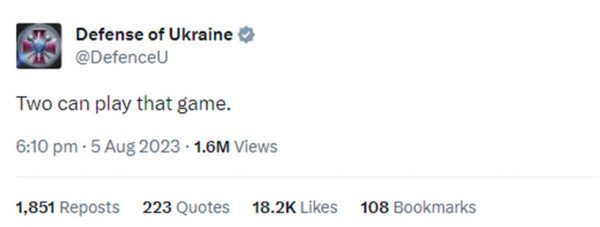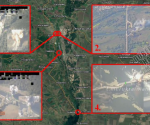A catalogue of setbacks for the anti-Russian axis; Part Four: The latest game changing wunderwaffe defeated
On 24th June, the Russian Ministry of Defence briefed that an attack had occurred in the preceding 24 hours on an air base in the vicinity of Starokonstantinov in the Khmelnitsky region. The target, as it could clearly be understood by the wording, had been selected because of a connection to a prior Ukrainian attack on a piece of infrastructure spanning a body of water between Kherson and Crimea. Here is the statement:
On 23 June, a storage of Storm Shadow cruise missiles has been destroyed at a Ukrainian airbase close to Starokonstantinov (Khmelnitsky region), in response to a strike on a road bridge across the Chongar Strait.
It’s hard, then, not to directly take the impression that the Russians reacted by hitting the site which had been the source of a provocation. Such is the distance between Starokonstantinov and the site of the bridge, about 400 miles, it becomes clear that the Ukrainians would have had to have used something from their limited long range arsenal, and both sides agree in any case that at least one Storm Shadow (able to travel 340 miles) struck something on the ground at its destination.
Much is made of the notion that Russia is often reduced to reacting to such Ukranian “blows”, and one should not be surprised to see “pro-Russian” “war correspondent” outfits – the OSINT-mongering Twaterati and the Telegram voenkors (wankers) – engaged in it. The author subscribes to the more sensible idea that there is a loss of cover or disguise when the Ukrainians, and their UK technician supervisors (no doubt), make preparations to and then launch ammunition stock that would be high on Russia’s “to-destroy” list because of its celebrity nature. The reaction to the Chongar road bridge attack, then, would be routine in a process of detection and response (with the detection obviously having taken place).
Fascinatingly, the Russians didn’t mention Storm Shadows when the airfield was attacked again on 5th August:
The Armed Forces of the Russian Federation launched a group strike with long-range high-precision air and sea-based weapons on air bases of the Armed Forces of Ukraine in the areas of the settlements of Starokonstantinov, Khmelnitsky region and Dubno, Rivne region. The target has been reached. All assigned objects are hit.
It was left very much to social media “expertise” to give meaning to the attack, after which there was consolidation from the likes of the Daily Mail:
Russia staged three waves of attacks this morning on a Ukrainian air base believed to house British- and French-supplied long-range Storm Shadow missiles.
A triple attack saw explosions in the vicinity of Starokonstantinov air base in Ukraine’s Khmelnytskyi region, according to reports.
The scale of any damage was not clear but Sergei Gamaly, the head of Ukraine’s regional military administration, said a ‘series of explosions’ had hit the area.
Russia had sent up seven Tu-95 nuclear-capable strategic bombers to unleash strikes with conventional Kh-101 missiles, reports said.
Russian sources said the Starokonstantinov base was used by Ukrainian Su-24 warplanes to fire Storm Shadows and French version SCALP-EGs at occupied lands.
What the reader is asked to pay incidental notice to is the use of the “pro-Russian” social media, which is what is meant by “Russian sources”, as the point of origin of a tale, and to form the core of what is going to be demonstrated as being yet another propaganda campaign. This site has shown over again how “pro-Russian” non-official war correspondence serves UK military intelligence.
Not long after this later Russian attack, an official Twitter account of the Ukrainian Ministry of Defence – manned, one would like to say, by 77th Brigade at its snottiest – issued the vague message, “Two can play that game”.
Then on 6th August there was a Ukrainian attack on the Chongar strait, of course using Storm Shadows, and the whole picture became clear.
What is revealed here is a scheme – no doubt coming directly from the minds steeped in the tradition of Orwell’s “if we say we are levitating, then we are” of the UK military junta – to make it appear (quite to the contrary in reality) as if Ukrainian acts of this kind have any great significance to them.
It all goes back to the topic of the anti-Russian axis’ tactics as used in Kharkov, attempted in Kherson, and that have no effectiveness against Russian forces who can now concentrate a defensive force and no longer have to withdraw when Ukrainians (and other NATO soldiery in the guise of mercenaries) drive columns of armour as quickly as possible through the territory they occupy in order to try and cut them off in it. Making the claim that the Russians are being cut off by long range missiles is an extra dimension being used in the dismal Ukrainian Zaporozhye campaign, and it gets a mention in the extract from a CNN article written about the June 22nd Ukrainian attack on the Chongar strait:
[it] is correct to say the one attack decides nothing. But it echoes two earlier events: the damage to the Antonovsky Bridge from Kherson City that eventually presaged Russia’s orderly withdrawal from the right side of the banks of the Dnipro River. And also, less directly, it echoes the damage done last year to the Kerch Strait bridge, which also temporarily disrupted traffic on the only southern supply artery to the peninsula from the Russian mainland. On Sunday, a blast hit what seemed to be a Russian ammunition depot in Rykove, near Chonhar. Blown bridges have a history of impacting both Russian morale and presence.
Alexei Zhivoff, a Russian military blogger, said Thursday the Chonhar bridge was more a “land corridor”, and carried 70% of the military and civilian traffic to and from Crimea. He added the blast showed the area was easily within reach of NATO-supplied missiles and that Russian air defences were inadequate.
It is reasonable to presume these targets have been known to the Ukrainians for some time, and the decision to hit them both in the past week is not an accident. They are likely waiting to impair supply lines to the Russian front lines in Zaporizhzhia at the most damaging time, hoping the sudden loss of supplies, or a panicked bid to restore them, will sap Russian defensive strength at a key moment.
As this site keeps trying to explain, it’s not that one should distrust the history or any information that the anti-Russian axis produces from one example to another according to its worth, it’s that the whole universe that is created by any outlet of that side dealing in shaping perception – all of it part of a military intelligence complex – is warped and malaligned to the truth.
One attack on the Antonovsky Bridge had nothing to do with the Russians withdrawing from the right side of the banks of the Dnipro River. In fact, if the reader recalls, the Antonovsky Bridge was only made redundant after the Russians had exited across it‡. The truck bomb that exploded on the Kerch Strait bridge – although you were told, by alternative media sold to you as being of the most trustworthy sort, that it signalled the imminence of a Zaporozhye offensive҂ – was isolated and meaningless. This CNN piece is only useful, apart from fact that it confirms that the “Russian sources” of western corporate-media are veonkors†, that it admits to the attack on the Chongar bridge as being psychological. As this site keeps trying to explain, psychology is their primary (and now, only) tool. “Magic”, The Anglo-Globalists’ Main Weapon, was written in 2018.
The plan of the anti-Russian axis in Zaporozhye has always been, by that Magician methodology, to keep sending bodies at the Russians until they develop a terrible fear about becoming isolated and trapped between Donetsk and Crimea, and concerned about the Ukrainian Human Wave then being able to make a difference. The Russians, remember, were also supposed to have been confidence tricked by the Prigozhin adventure (see Part Thee of this series) to believe that the Ukrainian “spring offensive” was being effective and causing their armies to mutiny.
So, according to the idea introduced previously, this scheme also requires the conjuring of an overawing impression of a powerful anti-Russian axis stand-off capability that can reach parts far behind the lines and there create havoc. Luckily, the anti-Russian axis had everything in place for the job.
If one searches the Daily Mail’s MailOnline site using the terms “Starokonstantinov”, “Storm Shadow”, and “June”, one isn’t offered coverage of the Russian attack in said month. On the other hand, one is given a link to a story about the August version: Russia launches three waves of missile and drone attacks on Ukrainian airbase ‘housing stocks of UK-supplied Storm Shadow missiles’. If one then searches the internet (Microsoft Bing, for instance) using the same terms, on the first page of results is an article published by The Sun entitled, Putin launches wave of missile and drone attacks on Ukraine airbase ‘housing UK-supplied Storm Shadow missiles’. Of course, the reference is to the August attack, and notice how two supposedly separate corporate-media titles have exactly the same thing to say about it. This would be because the narrative would have been decided upon by an office higher up in military intelligence apparatus, and ordered down to these mouthpieces posing as independent media entities.
Now, the reason why a searcher of the news of Russia’s June attack on the Starokonstantinov airbase would be disappointed is because the Ministry of Truth (Mi7) doesn’t promote or even publish information which is actually damaging to itself; i.e. UK Government. The reason, on the other hand, that the same searcher is regaled with the glorious detail of the August attack is because of the need to create an impression that Russia, Putin in particular, is desperate (in “three waves”) to destroy Storm Shadow cruise missiles as they are even sitting on the tarmac. In turn, this is because of the need to create an impression that Storm Shadow cruise missiles are an incredibly effective weapon, an enormous threat, and have the potential to cut off Russian forces with incredibly effective strikes on their means to remain connected to lines of command and supply.
In these circumstances, then, the Ukrainian Ministry of Defence’s strange Twitter outburst, timed to go out between Russian attack and Ukrainian retaliation, looks like a statement to the following effect: “Russia will pay for this impudence”. All in all, between the London-based military intelligence, it’s office in Kiev, and all its little voenkor assets pretending merrily away at being pro-Russian, a self-contained psyop around well-timed cruise missile launches!
The detail that really wins the case, of course, – and as already explained – is that after they had attacked the Starokonstantinov airbase in August, the Russians made no mention whatsoever about targeting Storm Shadows. The extract further up this page is all the statement they made about the issue. The issue of Storm Shadows being stored at the airfield during the August attack was played up – invented even – entirely by anti-Russian axis media.
Naturally, the necessity for a great magic show of military strength and capability comes about because of a reality in which no such thing exists, and when we look at the results of the UK Government’s efforts to panic the Russians into abandoning Zaporozhye, it is clear that it gets very little return from its expenditure – and we’re not just talking about the £790,000 that each Storm Shadow cost to build. It’s about reputational loss, and so says the optics of the Ukrainians suddenly finding urgent need for the German Taurus cruise missile as if the Storm Shadows failed to live up to expectations (more about that later).
On 7th August the Russians matter-of-factly stated that “Air defense facilities have intercepted nine Storm Shadow long-range cruise missile[s].” This would be nine of twelve that were fired at the Chongar strait – this tally appearing in the Daily Mail article cited above, attributed to Kherson’s regional governor.
Moreover, in their briefing of 22nd June (delivered 13:50 Moscow time), the Russian MoD stated that five Storm Shadow missiles had been shot down in the previous 24 hours. What is surely being referenced is the way that the Russians blunted the Ukrainian Storm Shadow attack on the Chongar strait of the same day.
Additionally, The Drive reported a July 29th attack that landed between two set of rails on the Chongar rail bridge (which is a twin at the same place of crossing as the road bridge), and this coincides with a Russian MoD briefing of the same date (14:30 Moscow time) which states that seven Storm Shadow cruise missiles were shot down. In fact, on that occasion the Russians also bagged two S-200 surface-to-air missiles (upgraded to attack ground targets) of the sort that was aimed at and missed the Kerch Bridge on 12th August (and prompted observers to wonder about the absence of any missiles from the UK).
In short, we can tell when the anti-Russian axis launches a Storm Shadow missile by the Russian MoDs account of it being shot down – more or less.
In return for this costly and embarrassing expenditure, the UK Government (Vladimir Saldo, the Kherson governor when his comments was quoted by the BBC in June, agreed with the author that the Ukrainian attack was “ordered by London”) has acquired very little. As far as the author can see, there was one hole made in the tarmac of the road bridge in June. Another, less serious divot was created in the surface of the road bridge in August. In July, a small section of rail may have been upset.
And actually the true scale of London’s debit balance is this: in the 41 days of the duration between 22nd June and 13th May, which is when the Russians first reported the use of Storm Shadows in an attack “on Polipak polymer products company and Milam meat processing plant in Lugansk” – so, two private civilian factories – at least 33 of the missiles had been shot down*. In the 46 days after that to 7th August, another 42 had been shot down. At least 75 in all.
On top of that, there was the June attack on the Starokonstantinov, with the Russians implying that they had destroyed Storm Shadows on the ground – and what else that day? We have it on good authority that parts of out-of-service Tornado jets are used to rig a Storm Shadow to a Ukrainian Su-24. It is highly probable that UK technicians need to be present wherever Storm Shadows are prepared and mounted to aircraft given this hybrid arrangement for maintenance of readiness. How many of these have now gone the same way as the other significantly skilled UK military personnel who have been caught, now and again, in the wrong Kievan or Odessan bunker at the wrong time?
We are told now that since 6th August that the SCALP-EG missile – which is the name that French call their Storm Shadows – has officially been in Ukrainian service, and that the decision to supply these weapons was confirmed by 11th July. The internet agrees in many places that the number of missiles supplied by Paris is 50. According to the Wikipedia entry for the Storm Shadow, the French appeared to have 700 of these things. The same page says that the UK had 700 to 1000. Although the amount sent to Ukraine by the UK was never disclosed, it might be fair to presume that a few more than 50, given the French donation, might be about right. In that case, it is quite possible that by the end of June it had become clear to anti-Russian axis planners that the French would need to confirm its shipment if the Ukrainians were not to be without Storm Shadows but one month into their “spring offensive”. Indeed, the author suspects that the SCALP-EG has been being used – shot down – much earlier than the official reckoning.
Of course, this might be entirely wrong, and the UK Government, in its conviction that the Russians are about to panic and leave Zaporozhye any day now, might have decided to commit as many of its Storm Shadow missiles as it believes is necessary to make it happen. After all, if it only takes one missile to land in the vicinity of a bridge into Kherson for a contingent psychological operation to be launched thereafter, then simultaneously losing a clutch of others, all at three quarters of a million a pop, must be thought worth the sacrifice. On the other hand (and note how the panicking language is at odds with the message of confidence of plenty that is constructed from it):
Defence experts see Taurus supplies as critical, as Ukraine’s stocks of Storm-Shadow missiles are expected to run out by the end of the year.
“If Berlin doesn’t start delivering now then there is a serious risk that Ukraine will run out of cruise missiles. That would be fatal for them,” according to Fabian Hoffmann, a defence expert at the University of Oslo.
‡ See Surovikin Said It Himself: The Kherson Withdrawal Is For “Offensives In Other Directions”, But This Detail Appears To Be Overlooked In All The Analysis (link)
҂ See The Zaporozhe “Offensive” And For It The Shaping Of The Battleground In Kherson (The “War On The Fields”), According To Propagandists For Ukraine (link)
† Another example, from the Daily Mail’s account of the Ukrainian attack in June:
Alexander Kots, military correspondent of Komsomolskaya Pravda newspaper said: ‘The enemy has begun to cut off Crimea from the Kherson region. ‘Storm Shadow missile strikes [have been made] on the bridge at Chongar – one of the isthmuses connecting the peninsula to the mainland.’
* On two occasions in this period, the Russians reported Storm Shadows amongst a number given generally for them and HIMARS projectiles. It means we can only say that at least one cruise missile was shot down each time, despite how in reality there might have been more.
Update, 15th August, 2023:
Funnily enough (meaning, quite the ironic coincidence), the Russian MoD today reports “Air defence facilities have intercepted four French-manufactured SCALP-EG long-range cruise missiles”. The French version is only different, as the author understands it, because it is intended for use by French planes. Presumably, then, it might only be software and the rigging apparatus differentiating the two (as a layman’s guess). The Russians, however, are seemingly able to tell them apart.



















